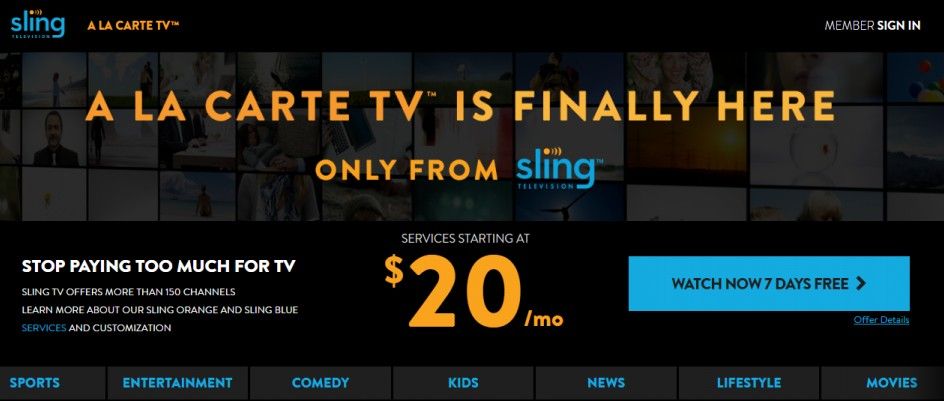The à la carte TV dream died before it ever got off the ground
Cordcutters are people who don’t subscribe (literally) to the traditional forms of TV. One of the biggest reasons for “cutting the cord” (ie. canceling your cable subscription) is the bloated channel lineups and inflated costs. Many people look at a long list of channels and see a lot of stuff they’ll never watch (but have to pay for). That’s where the dream of à la carte TV started, and for a while, it looked like it might actually happen. Not anymore.
À la carte TV is a pretty simple concept: You pay for what you want. In a perfect world, you would be able to pick the channels you want from a list and pay a price based on your selections. Only care about sports? Pick ESPN, FS1, and NBC Sports. Big comedy fan? Choose Comedy Central, TBS, and FX. For a multitude of reasons, that’s not really feasible, but a similar format was launched back in 2015 with Sling TV.
Sling TV arrived on the scene in 2015 with a modest 11-channel lineup and the low price of $20 per month. The idea was you pay $20 for a handful of basic channels and you could get add-on packages of channels for an additional $5. It offered a Sports pack, News pack, and Kids pack at launch. This wasn’t the perfect à la carte system (though they certainly advertised it as such), but it was the closest thing we had. I was one of the first people to try Sling TV, and as a cordcutting enthusiast, it felt like a big step in the right direction.
Many OTT (over-the-top) internet TV providers have popped up since then. Playstation Vue was a big name for a while, but it shut down in early 2020. Hulu has its own live TV service now. YouTube TV is another very popular choice (more on that later). Sling TV is still around too, and there are a variety of niche services on the market as well. All the major services have one thing in common, though: bloated channel lineups and inflated costs. Sound familiar?
Nowadays, Sling TV starts at $30 per month and you get over 50 channels. It still offers add-on packages, but the service is now divided into “Sling Blue” (FOX) and “Sling Orange” (Disney), and only certain add-ons work with certain packages. The other popular services have add-ons as well, but they’re basically just for “premium” channels. The idea of getting a cheap basic channel lineup and building off of that is basically dead.
This week, YouTube TV announced a drastic price hike of $15, putting it at a lofty $65 per month. The service that launched with 50 channels for $35 per month now boasts over 85 channels at nearly double the monthly price. Google has added channels numerous times and price jumps have been a yearly occurrence. In the same week, FuboTV, AT&T, and DirecTV also raised prices. Sling TV, on the other hand, just announced a 1 year price freeze in response to its competitors’ price hikes, but who knows how long they can commit to charging $30/month? Each of these services tout offering “more entertainment” to justify their decisions, but customers never get the choice to opt-out and keep their current price. That’s exactly what cable TV has done for years and why many people cut the cord to begin with.
Services like Sling TV and YouTube TV were seen as potential “disruptors” to the archaic cable TV system. Maybe that’s how they started, but the TV industry seems to have slowly beaten them down. Cable companies are losing more subscribers every year, but if big companies like Google can’t step in and force real change, I don’t think the à la carte TV dream is ever going to happen.
Now, this doesn’t mean there are no benefits to OTT Internet TV services. YouTube TV still offers an extremely easy setup process and the ability to stream content on basically every device you own. Plus, you can pause your subscription at any time and pick it back up later. Meanwhile, cable companies will nickel and dime you for “broadcast TV” fees and send bulky equipment to your house. There are certainly benefits to OTT TV, but price and choice is not part of that equation anymore.
À la carte TV remains out of reach for cordcutters and current trends indicate it will remain that way for a long time. If you asked me 5 years ago if we’d have à la carte TV in 2020, I may not have thought it’d be perfect, but I certainly would have expected more progress. In many ways, it feels like we are actually further from that goal than we were in 2015. YouTube TV isn’t the only culprit, but it’s yet another promising service that has failed to make real change.
The post The à la carte TV dream died before it ever got off the ground appeared first on xda-developers.
from xda-developers https://ift.tt/2YQlULV
via IFTTT


No comments: